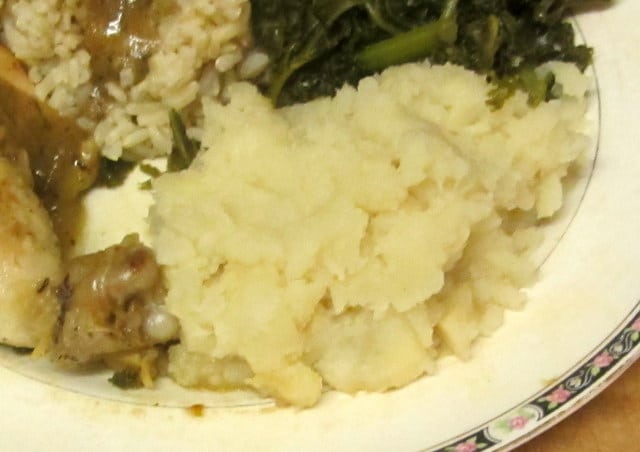Celery Root
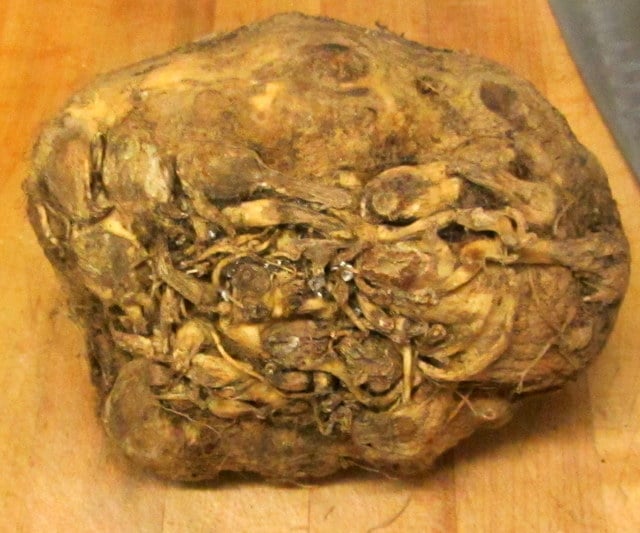 That’s an unprepossessing lump, isn’t it?
That’s an unprepossessing lump, isn’t it?
All right – those of you in Europe are probably looking at this blankly, wondering why I bother to write about something so simple, and why I wouldn’t know at a glance how good this can taste. I gather it is readily available, and pretty commonly used, in most of Europe.
Here in the United States, though, it’s not common at all – which is really rather a pity. Root vegetables in general have been given too little attention (other than carrots – for some reason we’re all about carrots!) I think this is partly because so many parts of the US have extended growing seasons – why bother with storage vegetables when you can grow them fresh all year, in Florida and Southern California – and much of the year in other areas?
Well – because they taste good, in and of themselves?
More and more of us, in the areas with distinct seasons, are discovering the joys of seasonal cooking and eating. Yes, some push for all local, all the time – but many of us follow a compromise. On the one hand, I can’t imagine why I, in the State of New York, with some of the best apple growing regions on earth, would eat an apple from Washington, on the other side of the continent. On the other hand, I certainly will eat oranges from Florida… they grow lovely oranges, and we don’t. (I do eat more apples than oranges… and I would assume someone in Florida eats more oranges than apples, since apples don’t grow there.) Equally, I definitely eat some frozen vegetables and fruit, and some vegetables brought up from Florida, because there just isn’t much in season here, from January through March (even April, if it’s a cool spring.)
But I, personally would rather eat more of the cabbage, parsnips, and other winter storage vegetables that grow here. And because of our demand, local farmers are starting to grow more of these storage vegetables, and sell them throughout the winter. Five or six years ago, there was only one farmer selling root crops all winter at Union Square Greenmarket, and they were there only one day a week – everyone else just had apples and potatoes (the only storage food we’ve always been willing to buy, for some reason) or meat and bread. Now, it seems that every year brings another booth or two with turnips, parsnips, and kohlrabi…
And celeriac.
Actually, I got this one from my CSA. The great thing about storage vegetables is that they… store well… This has been sitting happily in my crisper drawer with the butternut squash and the cabbage for a month, now. I’d considered simply making the celeri remoulade I wrote about last year – but we haven’t really hit the yearning for salad stage… in December, we’re not yet tired of warm creamy dishes. And the other thing people do with this seems to, in fact, be warm and creamy – mashed, or in a cream soup.
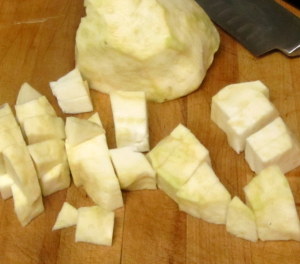 I trimmed the celeriac. Well – trim isn’t really the word – it somehow suggests moderation, in the way that trimming one’s hair is different from cutting one’s hair.. Celery root is gnarly, and bumpy, and grows in dirt and all those indentations and dimples and dents are chock full of good growing soil – that you don’t want on your plate. You have to cut down beyond them. The first few times you do it, it feels terribly wasteful, especially if you were raised scrubbing, rather than peeling, your carrots and potatoes to keep the food value (as I was.) Grit your teeth, grab a big knife, and slash away – it’s the only way. (My earlier post does have pictures and a discussion of the process.) At the end, you may still need to get a small sharp paring knife and cut out little pockets of dirt that are still in it. Keep going until you get rid of all the dark seams and pockets.
I trimmed the celeriac. Well – trim isn’t really the word – it somehow suggests moderation, in the way that trimming one’s hair is different from cutting one’s hair.. Celery root is gnarly, and bumpy, and grows in dirt and all those indentations and dimples and dents are chock full of good growing soil – that you don’t want on your plate. You have to cut down beyond them. The first few times you do it, it feels terribly wasteful, especially if you were raised scrubbing, rather than peeling, your carrots and potatoes to keep the food value (as I was.) Grit your teeth, grab a big knife, and slash away – it’s the only way. (My earlier post does have pictures and a discussion of the process.) At the end, you may still need to get a small sharp paring knife and cut out little pockets of dirt that are still in it. Keep going until you get rid of all the dark seams and pockets.
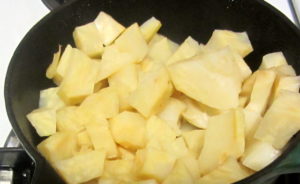 Hard part is done, now… I cubed the trimmed root, dropped it in a small saucepan with some water, and brought it to a boil. I lowered the heat to a simmer, covered it, and let it partly simmer, partly steam for about 20 minutes, while I cooked the rest of dinner. Then I drained off most of the small amount of water that was left (you might use it in soup, or as a braising liquid for something else, as it has a faint but nice celery flavor.)
Hard part is done, now… I cubed the trimmed root, dropped it in a small saucepan with some water, and brought it to a boil. I lowered the heat to a simmer, covered it, and let it partly simmer, partly steam for about 20 minutes, while I cooked the rest of dinner. Then I drained off most of the small amount of water that was left (you might use it in soup, or as a braising liquid for something else, as it has a faint but nice celery flavor.)
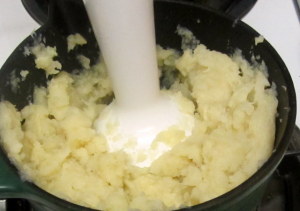 It was completely tender to the tip of a knife, but still seemed to slightly resist the potato masher – so I used my immersion blender to mash it, and that worked easily and beautifully. The small amount of water I’d left in the pan helped it whip up nice and fluffy.
It was completely tender to the tip of a knife, but still seemed to slightly resist the potato masher – so I used my immersion blender to mash it, and that worked easily and beautifully. The small amount of water I’d left in the pan helped it whip up nice and fluffy.
It is usually, logically enough, described as tasting like celery – but that doesn’t really capture it. So much of the celery we get these days is very bland – bought for the crunch, more than the taste – and some has a slight bitterness to it. This tasted warm and a little sweet, with an overtone of celery. I think it would make a very delicate cream soup – something I’d serve in fine china cups as a first course, rather than a hearty meal in a bowl… I read that people mix it with mashed potatoes, and I don’t think I would do that – I think it would bland it out (though I can see it instead working to add taste to the potatoes, if you didn’t have gravy. And it might be a good way to introduce it to the family.) I just served the mash itself – didn’t even add (or want) any butter! A warm, bright, sweet taste on a cold winter day. 